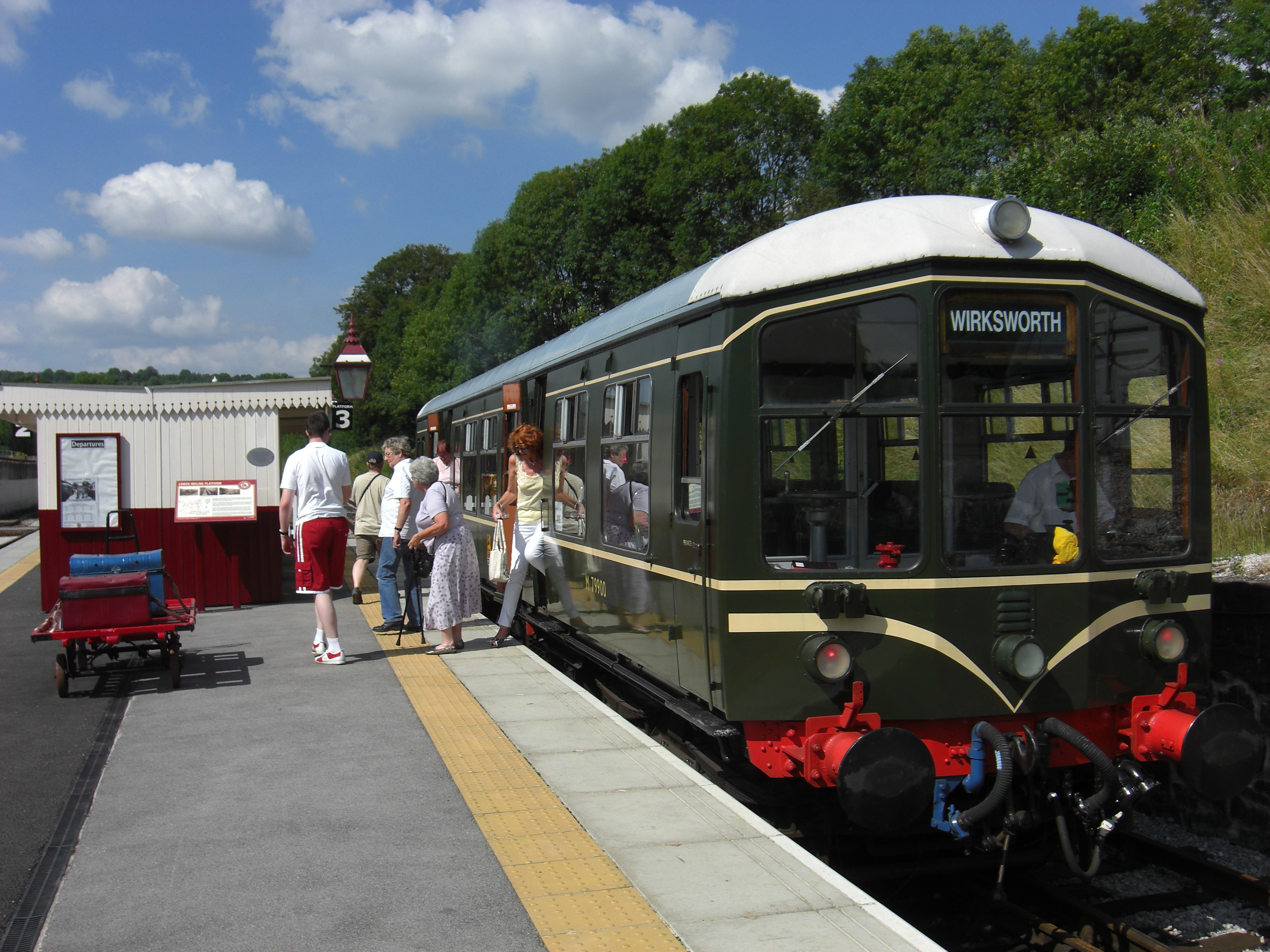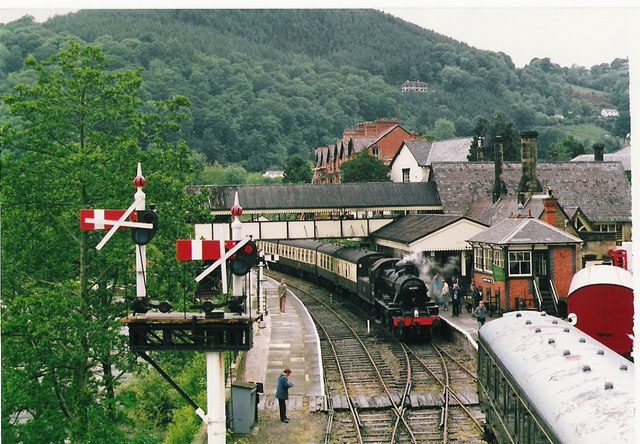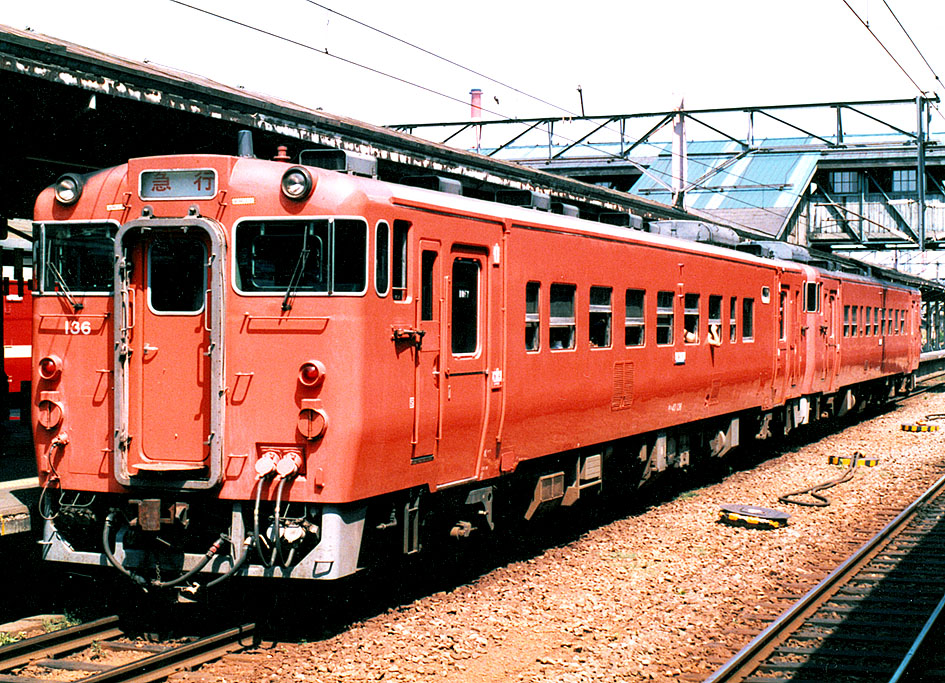|
British Rail Class 109
The British Rail Class 109 is a class of 2-car diesel multiple units built in 1957 by D Wickham & Co. Five two-car units were built featuring an unusual body design. The design, first used in 1936 for South American railways, aimed to minimise weight. It had no underframe, but the whole body was formed into a welded stress-bearing box girder made of solid drawn steel tube. Aluminium was used for panels, luggage racks, window frames, vacuum pipes and fuel and vacuum tanks. The corrugated steel floor was filled with sprayed asbestos and covered with asbestos-filled flame-proofed hardboard and rubber sheet. The units soon became non-standard and two were sold back to the manufacturer who exported them to Trinidad and Tobago. Another unit was converted into departmental service, and survived in BR ownership until the early 1980s. Vehicle numbers Further use One two-car set (50416+56171) was extensively overhauled in 1967 at Doncaster, revamping the interiors and adding ki ... [...More Info...] [...Related Items...] OR: [Wikipedia] [Google] [Baidu] |
List Of British Rail Diesel Multiple Unit Classes
This is a list of British Rail diesel multiple-unit train classes. For a historical overview of diesel multiple unit train development in Great Britain, see British railcars and diesel multiple units. Pre-nationalisation designs * GWR railcars * LMS railcars First Generation Early BR DMUs (79xxx series) TOPS classes Second generation Lightweight railcars Pacers Sprinters Turbos Networker Turbostar Coradias Desiro Civity Diesel-electric multiple units (DEMUs) Southern Region DEMUs Second Generation Voyager-style express DEMUs High-speed trains See also * List of British Rail electric multiple unit classes * British Rail locomotive and multiple unit numbering and classification * British Rail coach type codes British Railways coach designations were a series of letter-codes used to identify different types of coaches, both passenger carrying and non-passenger carrying stock (NPCS). The code was generally painted on the end of the coach but no ... [...More Info...] [...Related Items...] OR: [Wikipedia] [Google] [Baidu] |
South America
South America is a continent entirely in the Western Hemisphere and mostly in the Southern Hemisphere, with a relatively small portion in the Northern Hemisphere at the northern tip of the continent. It can also be described as the southern Subregion#Americas, subregion of a single continent called Americas, America. South America is bordered on the west by the Pacific Ocean and on the north and east by the Atlantic Ocean; North America and the Caribbean Sea lie to the northwest. The continent generally includes twelve sovereign states: Argentina, Bolivia, Brazil, Chile, Colombia, Ecuador, Guyana, Paraguay, Peru, Suriname, Uruguay, and Venezuela; two dependent territory, dependent territories: the Falkland Islands and South Georgia and the South Sandwich Islands; and one administrative division, internal territory: French Guiana. In addition, the ABC islands (Leeward Antilles), ABC islands of the Kingdom of the Netherlands, Ascension Island (dependency of Saint Helena, Asce ... [...More Info...] [...Related Items...] OR: [Wikipedia] [Google] [Baidu] |
Llangollen Railway
The Llangollen Railway () is a volunteer-run heritage railway in Denbighshire, North Wales, which operates between Llangollen and Corwen. The standard gauge line, which is long, runs on part of the former Ruabon – Barmouth GWR route that closed in 1965. It operates daily services in the summer as well as weekends throughout the winter months, using a variety of mainly ex-GWR steam locomotives as well as several diesel engines and diesel multiple units. A extension of the railway has been built to complete the line to Corwen. In March 2021 the railway company announced that, having made a loss in three consecutive years, they had invited their bank to appoint receivers. History Commercial Service: 1865–1962 Llangollen was already a popular place for tourists by the 1840s. Travel up to this time had been by horse-drawn carriage, but by the 1840s the Shrewsbury to Chester line had been completed, which allowed passengers to alight at (later known as Whitehurst Halt), a ... [...More Info...] [...Related Items...] OR: [Wikipedia] [Google] [Baidu] |
Trinidad And Tobago
Trinidad and Tobago (, ), officially the Republic of Trinidad and Tobago, is the southernmost island country in the Caribbean. Consisting of the main islands Trinidad and Tobago, and numerous much List of islands of Trinidad and Tobago, smaller islands, it is situated south of Grenada and off the coast of northeastern Venezuela. It shares maritime boundary, maritime boundaries with Barbados to the northeast, Grenada to the northwest and Venezuela to the south and west. Trinidad and Tobago is generally considered to be part of the West Indies. The island country's capital is Port of Spain, while its largest and most populous city is San Fernando, Trinidad and Tobago, San Fernando. The island of Trinidad was inhabited for centuries by Indigenous peoples of the Americas, Indigenous peoples before becoming a colony in the Spanish Empire, following the arrival of Christopher Columbus, in 1498. Spanish governor José María Chacón surrendered the island to a British fleet under t ... [...More Info...] [...Related Items...] OR: [Wikipedia] [Google] [Baidu] |
Asbestos
Asbestos () is a naturally occurring fibrous silicate mineral. There are six types, all of which are composed of long and thin fibrous crystals, each fibre being composed of many microscopic "fibrils" that can be released into the atmosphere by abrasion and other processes. Inhalation of asbestos fibres can lead to various dangerous lung conditions, including mesothelioma, asbestosis, and lung cancer, so it is now notorious as a serious health and safety hazard. Archaeological studies have found evidence of asbestos being used as far back as the Stone Age to strengthen ceramic pots, but large-scale mining began at the end of the 19th century when manufacturers and builders began using asbestos for its desirable physical properties. Asbestos is an excellent electrical insulator and is highly fire-resistant, so for much of the 20th century it was very commonly used across the world as a building material, until its adverse effects on human health were more widely acknowl ... [...More Info...] [...Related Items...] OR: [Wikipedia] [Google] [Baidu] |
Tube Drawing
Tube drawing is a process to size a tube by shrinking a large diameter tube into a smaller one, by drawing the tube through a die. This process produces high-quality tubing with precise dimensions, good surface finish, and the added strength of cold working.Degarmo, p. 433. For this reason this process is established for many materials, mainly metalworking but also glass. Because it is so versatile, tube drawing is suitable for both large- and small-scale production. The large-scale production of glass typically uses a one step process where glass is directly drawn into a tube from a melting tank. There are five types of tube drawing: tube sinking, mandrel drawing, stationary mandrel, moving mandrel, and floating mandrel. A mandrel is used in many of the types to prevent buckling or wrinkling in the workpiece. Processes Tube sinking Tube sinking, also known as ''free tube drawing'', reduces the diameter of the tube without a mandrel inside the tube. The inner diameter is determin ... [...More Info...] [...Related Items...] OR: [Wikipedia] [Google] [Baidu] |
Underframe
An underframe is a framework of wood or metal carrying the main body structure of a railway vehicle, such as a locomotive, carriage or wagon. See also * Chassis * Headstock * Locomotive bed * Locomotive frame A locomotive frame is the structure that forms the backbone of the railway locomotive, giving it strength and supporting the superstructure elements such as a cab, boiler or bodywork. The vast majority of locomotives have had a frame structure ... * Undercarriage References {{rail-stub Locomotive parts ... [...More Info...] [...Related Items...] OR: [Wikipedia] [Google] [Baidu] |
D Wickham & Co
The Wickham trolley was a railway engineering personnel carrier built by D. Wickham & Co of Ware, Hertfordshire. This long established firm introduced their rail trolley in 1922 as a lightweight track inspection and maintenance vehicle. This was a success and production of rail trolleys and railcars for inspection and maintenance continued until 1990. Company history Dennis Wickham founded the company in 1886 as Motor Car and General Engineers with workshops in Priory Street, Ware. He came from a brewing family and an early product was machinery for breweries. In 1900 they moved to larger premises at Viaduct Road at the entrance to Crane Mead next to the river. The area was later redeveloped for town houses and was renamed Wickham Wharf. Dennis Wickham died in 1910, but the business continued and flourished. The company operated as D Wickham & Co. Ltd of Ware & Stevenage (Hertfordshire, UK), Wickham Rail Ltd of Suckley & Bishop's Frome ( Worcestershire, UK) and Wickham Rail Ca ... [...More Info...] [...Related Items...] OR: [Wikipedia] [Google] [Baidu] |
British Rail
British Railways (BR), which from 1965 traded as British Rail, was a state-owned company that operated most of the overground rail transport in Great Britain from 1948 to 1997. It was formed from the nationalisation of the Big Four (British railway companies), Big Four British railway companies, and was privatisation of British Rail, privatised in stages between 1994 and 1997. Originally a trading brand of the Railway Executive of the British Transport Commission, it became an independent statutory corporation in January 1963, when it was formally renamed the British Railways Board. The period of nationalisation saw sweeping changes in the railway. A process of dieselisation and Railway electrification in Great Britain, electrification took place, and by 1968 steam locomotives had been entirely replaced by diesel and electric traction, except for the Vale of Rheidol Railway (a narrow-gauge railway, narrow-gauge tourist line). Passenger train, Passengers replaced freight train, ... [...More Info...] [...Related Items...] OR: [Wikipedia] [Google] [Baidu] |
Diesel Multiple Unit
A diesel multiple unit or DMU is a multiple-unit train powered by on-board diesel engines. A DMU requires no separate locomotive, as the engines are incorporated into one or more of the carriages. Diesel-powered single-unit railcars are also generally classed as DMUs. Diesel-powered units may be further classified by their transmission type: diesel–mechanical DMMU, diesel–hydraulic DHMU, or diesel–electric DEMU. Design The diesel engine may be located above the frame in an engine bay or under the floor. Driving controls can be at both ends, on one end, or in a separate car. Types by transmission DMUs are usually classified by the method of transmitting motive power to their wheels. Diesel–mechanical In a diesel–mechanical multiple unit (DMMU), the rotating energy of the engine is transmitted via a gearbox and driveshaft directly to the wheels of the train, like a car. The transmissions can be shifted manually by the driver, as in the great majority of first-ge ... [...More Info...] [...Related Items...] OR: [Wikipedia] [Google] [Baidu] |
Corridor Connection
A gangway connection (or, more loosely, a corridor connection) is a flexible connector fitted to the end of a railway coach, enabling passengers to move from one coach to another without danger of falling from the train. Origins: Coaches in British and American railways The London and North Western Railway (LNWR) was the first British railway to provide passengers with the means to move from one coach to another while the train was in motion. In 1869 the LNWR built a pair of saloons for the use of Queen Victoria; these had six-wheel underframes (the bogie coach did not appear in Britain until 1874), and the gangway was fitted to only one end of each coach. The Queen preferred to wait until the train had stopped before using the gangway. In 1887, George M. Pullman introduced his patented vestibule cars. Older railroad cars had open platforms at their ends, which were used both for joining and leaving the train, but could also be used to step from one car to the next. This pra ... [...More Info...] [...Related Items...] OR: [Wikipedia] [Google] [Baidu] |




.jpg)

